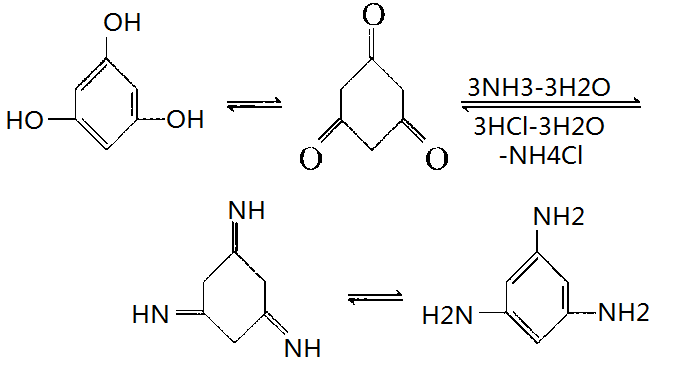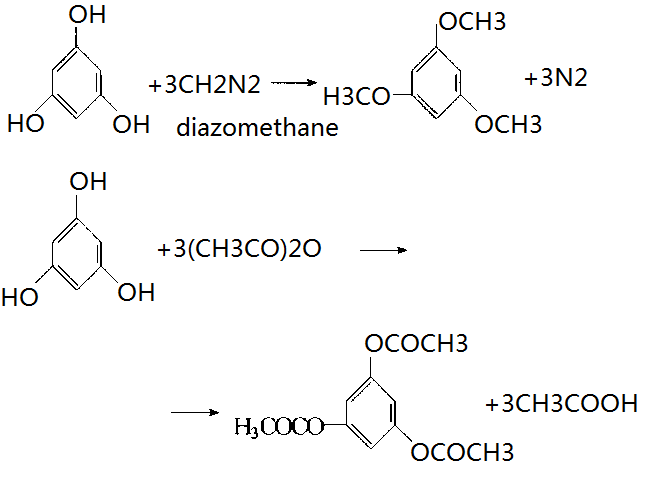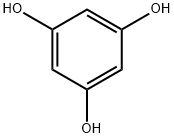ChemicalBook > CAS DataBase List > Phloroglucinol
Phloroglucinol
Feature reaction of phloroglucinol Chemical properties Uses Production method Hazards & Safety Information
Phloroglucinol
- CAS No.108-73-6
- Chemical Name:Phloroglucinol
- CBNumber:CB0667672
- Molecular Formula:C6H6O3
- Formula Weight:126.11
- MOL File:108-73-6.mol
Phloroglucinol Property
- Melting point 215-220 °C
- Boiling point 194.21°C (rough estimate)
- Density 0.801 g/mL at 20 °C
- bulk density 560kg/m3
- vapor pressure 0.001Pa at 25℃
- refractive index n
20/D 1.365 - Flash point 14 °C
- storage temp. Store below +30°C.
- solubility Soluble in diethyl ether, ethanol and pyridine.
- form Crystalline Powder
- pka pK1:8.45(0);pK2:8.88(-1) (25°C)
- color White to light beige
- Water Solubility 11.17g/L(room temperature)
- Sensitive Light Sensitive & Hygroscopic
- Merck 14,7328
- BRN 1341907
- InChIKey QCDYQQDYXPDABM-UHFFFAOYSA-N
- LogP 0.55 at 25℃
- CAS DataBase Reference 108-73-6(CAS DataBase Reference)
- EWG's Food Scores 3-6
- FDA UNII DHD7FFG6YS
- ATC code A03AX12
- NIST Chemistry Reference 1,3,5-Benzenetriol(108-73-6)
- EPA Substance Registry System 1,3,5-Benzenetriol (108-73-6)
- UNSPSC Code 41116107
- NACRES SE.11
Safety
- Hazard Codes :F,Xi
- Risk Statements :11-36/37/38-34-43
- Safety Statements :7-16-24/25-45-36/37/39-26-36/37-37/39
- RIDADR :UN 1170 3/PG 2
- WGK Germany :2
- RTECS :SY1050000
- TSCA :Yes
- HS Code :29072900
- Toxicity :LD50 in mice, rats (g/kg): 4.7, 4.0 i.g. (Cahen)
-
NFPA 704:
0 2 1
-
Symbol(GHS)

- Signal wordWarning
- Hazard statements H315-H317-H319-H335
- Precautionary statements P261-P264-P271-P280-P302+P352-P305+P351+P338
Phloroglucinol Price
More Price(17)
- Brand: Sigma-Aldrich(India)
- Product number: P3502
- Product name : Phloroglucinol
- Purity: Used to detect the presence of wood fiber.
- Packaging: 25G
- Price: ₹3615.55
- Updated: 2022/06/14
- Buy: Buy
- Brand: Sigma-Aldrich(India)
- Product number: P3502
- Product name : Phloroglucinol
- Purity: Used to detect the presence of wood fiber.
- Packaging: 100G
- Price: ₹6007.88
- Updated: 2022/06/14
- Buy: Buy
- Brand: Sigma-Aldrich(India)
- Product number: P1178
- Product name : Phloroglucinol
- Purity: suitable for plant cell culture, BioReagent
- Packaging: 100G
- Price: ₹10933.25
- Updated: 2022/06/14
- Buy: Buy
- Brand: Sigma-Aldrich(India)
- Product number: 79330
- Product name : Phloroglucinol
- Purity: ≥99.0% (HPLC)
- Packaging: 25G
- Price: ₹4578.98
- Updated: 2022/06/14
- Buy: Buy
- Brand: Sigma-Aldrich(India)
- Product number: 8.18887
- Product name : Phloroglucinol
- Purity: for synthesis
- Packaging: 100G
- Price: ₹10810
- Updated: 2022/06/14
- Buy: Buy
Phloroglucinol Chemical Properties,Usage,Production
-
Feature reaction of phloroglucinol
Reaction of formaldehyde with phloroglucinol under alkaline conditions generates orange compound. The colorimetric assay determination of this compound at the maximum absorption wavelength of 460 nm, can be used to detect low or trace formaldehyde in textile and garment.
Since phloroglucinol may occur enol and keto tautomers, it can react with ammonia according following reaction:

Under the influence of ammonia, 1,3,5-Benzenetriamine can be obtained by keto reaction of phloroglucinol, while this amine can also hydrolyze in aqueous acid to generate phloroglucinol. Besides phloroglucinol can also have enol reaction.

The information above is edited by Andy from Chemicalbook. - Chemical properties This product is a white or light yellow crystal or crystalline powder with melting point of 218 ℃. Usually it carries two molecular crystallization water ([6099-90-7]) and converts into anhydrous at 110 ℃. It can be dissolved in 100 parts of water, 10 parts of ethanol, and 0.5 parts of pyridine and is soluble in ether. Besides It partially decomposes when sublimation, and changes its color when exposed to the light. In addition it tastes sweet.
- Uses Phloroglucinol can be used in verifications of antimony, arsenic, cerium, chromate, chromium, gold, iron, mercury, nitrites, osmium, palladium, tin, vanadium, vanillin and lignin, and measurement of furfural, pentose, pentosan, methanol, chloral hydrate, turpentine, Lignified cell tissues, free acid in gastric juice (HCl) and decalcified bone specimens. Besides it can also be used as biological reagent dyes.
- Production method 2,4,6-aminobenzoic acid can be obtained by 2,4,6-trinitrobenzoic acid`s reduction of zinc particles. After its dilute solution was heated at reflux for 20h, acidified with hydrochloric acid, cooled and crystallized, phloroglucinol can be obtained with a yield of 46-53%.
-
Hazards & Safety Information
Category: Toxic substances
Toxicity grade: Moderate toxicity
Acute toxicity: oral-rat LD50: 4000 mg/kg; Oral-Mouse LD50: 4550 mg/kg
Flammability hazard characteristics: Combustible fire burning can cause smoke irritation
Storage characteristics: Ventilated, low-temperature and dry warehouse; and separately with oxidants
Extinguishing agents: Carbon dioxide, foam, sand and water mist - Description Phloroglucinol is a naturally occurring phenol that exhibits diverse biological activities. Phloroglucinol protects V79-4 Chinese hamster lung fibroblast cells from oxidative stress and inhibits lipid peroxidation by scavenging reactive oxygen species (ROS). It induces apoptosis in HT-29 human colon cancer cells and inhibits metastasis of BT549 and MDA-MB-231 human breast cancer cells. Phloroglucinol protects primary neurons from β-amyloid-induced dendritic spine loss in vitro and shortens the latency to find the platform in a Morris water maze test in an Alzheimer’s disease (AD) mouse model. Phloroglucinol has been used to stain histological plant sections and in the synthesis of numerous natural products. Phloroglucinol slows the frequency and decreases the amplitude of contraction in isolated rabbit and rat intestine at a concentration of 100 and 1 μM, respectively. Formulations containing phloroglucinol have been used as antispasmodics.
- Chemical Properties white to light yellow crystal
- Physical properties Phloroglucinol crystallizes in the anhydrous form or as the dihydrate. Recrystallization from water gives the dihydrate, which is colorless, oderless, sweet in taste, and forms rhombic crystals. The dihydrate is converted into the anhydrous form by heating at 110 ℃. Phloroglucinol sublimes at higher temperatures with partial decomposition.
- Uses Phloroglucinol is mainly used as a coupling agent in printing. It is an active component of Tollen's reagent and Gunzburg reagent used to test pentoses and hydrochloric acid in gastric juice respectively. In analytical chemistry, it is used to study condensed tannins by means of depolymerization. It is also involved in the synthesis of 2,4,6-triamino-1,3,5- trinitrobenzene, trinitrophloroglucinol and pharmaceuticals like flopropione.
- Uses Phloroglucinol (1,3,5-trihydroxybenzene) is the core structure of a large family of substituted phenolics with broad, albeit weak, biological activity. Phloroglucinol is a useful metabolite for HPLC/DAD and bioassay dereplication.diagnostic aid growth hormone releasing factor. Antispasmodic.
- Definition ChEBI: Phloroglucinol is a benzenetriol with hydroxy groups at position 1, 3 and 5. It has a role as an algal metabolite.
-
Application
Phloroglucinol (phlo) is a phenol derivative that shows cyctoprotective effect from oxidative damage by enhancing the activity of cellular catalase.
It can react with benzaldehyde derivatives to form phloroglucinol-based microporous polymeric organic frameworks (phlo-POF) with potential applications in ion-exchange and gas adsorption.
Phlo can also be used to prepare synthetic analogs of A-type proanthocyanidins (PACs) such as 2,8-dioxabicyclo[3.3.1]nonane derivatives by reacting with the corresponding flavylium salts. - General Description Phloroglucinol is a trihydroxybenzene with antithrombotic, profibrinolytic, antimicrobial, antimalarial, cancer chemopreventive, anti-HIV and anti-leishmanial activities. Phloroglucinol (PG) is a biosynthetic precursor of the 2,4-diacetylphloroglucinol (DAPG) an antibiotic against soil-borne diseases. Phloroglucinol is a useful intermediate because it is polyfunctional.
- Flammability and Explosibility Not classified
- Safety Profile Moderately toxic by subcutaneous and intraperitoneal routes. Mildly toxic by ingestion. Experimental reproductive effects. Mutation data reported. When heated to decomposition it emits acrid smoke and irritating fumes. Used in diazo-type printing and textile dyeing, in microscopy as a bone specimen decalcifier
- Purification Methods Crystallise the triol from water, and store it in the dark under nitrogen. [Beilstein 6 IV 7361.]
Phloroglucinol Preparation Products And Raw materials
Raw materials
Preparation Products
Global(586)Suppliers
-
Supplier:
EAST STAR BIOTECH (SUZHOU) CO., LTD.
- Tel: +8617706846989
- Email:marketing@eaststarbio.com
- Country:China
- ProdList:48
- Advantage:58
-
Supplier:
Shanghai Zhuangming Biopharma Co., Ltd.
- Tel:+86-19189228086<br/>+86-18858568638
- Email:sales@zmsilane.com
- Country:China
- ProdList:638
- Advantage:58
-
Supplier:
Hebei Chuanghai Biotechnology Co., Ltd
- Tel: +8615531157085
- Email:abby@chuanghaibio.com
- Country:China
- ProdList:8808
- Advantage:58
-
Supplier:
Hebei Mujin Biotechnology Co.,Ltd
- Tel:+86 13288715578<br/>+8613288715578
- Email:sales@hbmojin.com
- Country:China
- ProdList:12811
- Advantage:58
-
Supplier:
Hebei Chuanghai Biotechnology Co,.LTD
- Tel: +86-13131129325
- Email:sales1@chuanghaibio.com
- Country:China
- ProdList:5869
- Advantage:58
-
Supplier:
Henan Bao Enluo International TradeCo.,LTD
- Tel:+86-17331933971<br/>+86-17331933971
- Email:deasea125996@gmail.com
- Country:China
- ProdList:2472
- Advantage:58
-
Supplier:
Hebei Mujin Biotechnology Co.,Ltd
- Tel: +8613288715578
- Email:angelia@hbmojin.com
- Country:China
- ProdList:750
- Advantage:58
-
Supplier:
Capot Chemical Co.,Ltd.
- Tel:+86-(0)57185586718<br/>+86-13336195806
- Email:sales@capot.com
- Country:China
- ProdList:29730
- Advantage:60
-
Supplier:
Shanghai Daken Advanced Materials Co.,Ltd
- Tel:+86-371-+86-371-66670886
- Email:info@dakenam.com
- Country:China
- ProdList:19809
- Advantage:58
-
Supplier:
Henan Tianfu Chemical Co.,Ltd.
- Tel:+86-0371-55170693<br/>+86-19937530512
- Email:info@tianfuchem.com
- Country:China
- ProdList:21628
- Advantage:55
Related articles
108-73-6, PhloroglucinolRelated Search:
- Phenol Hydroquinone Resorcinol Holmium chloride Tin(Ⅱ)chloride anhydrous CERIC SULFATE Copper(II) acetate Potassium iodide Tetrasodium pyrophosphate Lanthanum(III) chloride Calcium chloride Potassium fluoride o-Phenanthroline Sodium iodide 4-HYDROXYBENZENESULFONIC ACID SODIUM SALT HYDRATE MANGANESE(II) ACETATE TRIMETHYL PHLOROGLUCINOL Myricetin
- bc0001
- 108-73-6
- Pharmaceuticals
- Intermediates & Fine Chemicals
- Inhibitors
- Allium sativum (Garlic)
- Allium cepa (Onion)
- Aromatic Phenols
- Aromatics
- Plant Growth Trgulators (Others)
- Plant Growth Regulators
- Biochemistry
- Aromatics Compounds
- Benzene derivates
- Phenol&Thiophenol&Mercaptan
- ACTIVE PHARMACEUTICAL INGREDIENTS
- s wort)
- Polyols
- Phytochemicals by Plant (Food/Spice/Herb)
- Oxygen Compounds
- Organic Building Blocks
- Nutrition Research
- Fucus vesiculosus
- Chemical Synthesis
- Building Blocks
- 酚类
- 高端化学
- 有机类
- 中间体产品
- 大化工
- 化学试剂
- 生化研究试剂
- 生化试剂
- 基因组学和分子诊断
- 通用试剂
- 化工
- 有机产品
- 有机原料
- 有机化工
- 氟化物
- 有机中间体
- 化工原料
- 原料药
- 添加剂
- 中间体-有机中间体
- 医用原料
- 有机化工原料
- 精细化工品
- 有机砌块
- 中间体
- 微生物代谢物
- 医药中间体
- 酚
- 芳烃
- 农残、兽药及化肥类
- 医药原料
- 伊卢多啉中间体
- 苯酚
